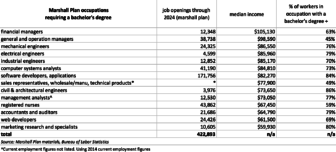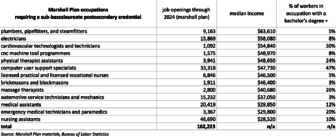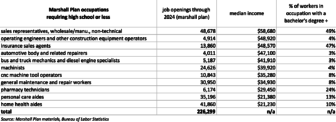![]() The Marshall Plan for Talent came with an implicit message to Michigan high school students: four-year degrees aren’t necessary to get ahead in tomorrow’s economy. Billed as a revolutionary approach to education, Governor Snyder envisions a competency-based system heavy on short-term credentials and light on four-year degrees. In an interview with Crain’s about the plan Snyder said:
The Marshall Plan for Talent came with an implicit message to Michigan high school students: four-year degrees aren’t necessary to get ahead in tomorrow’s economy. Billed as a revolutionary approach to education, Governor Snyder envisions a competency-based system heavy on short-term credentials and light on four-year degrees. In an interview with Crain’s about the plan Snyder said:
Think about the work world as a practical matter: The only time you really care about someone’s degree is if someone’s talking about who’s playing football or basketball. Nobody cares once you’re on the job six months or a couple years. It’s not relevant.
The labor market, however, begs to differ.
The presentation that accompanied the rollout listed high-demand occupations, along with the total number of available jobs projected through 2024 in each occupation, and the average salary in that occupation. The Marshall Plan calculates the average salary for all these occupations as just over $60,000. However, that average hides the fact that nearly all of the occupations that pay $60,000 or more require a bachelor’s degree or higher.
Below are three charts, showing the target occupations listed in the governor’s plan, split by the education typically required for entry to the occupation, defined by the Bureau of Labor Statistics. The charts show the number of job openings projected through 2024 using the figures in the Marshall Plan materials (though we have some questions on the validity of these figures, as they’re far different from the official projections released by the state’s Department of Technology, Management, and Budget); the median income of that occupation; and the percentage of workers in that occupation with a bachelor’s degree or higher.



As you can see, of the 38 occupations listed (the Marshall Plan materials list 37 occupations, as the two sales representatives occupations are collapsed to a single category), 15 have a median income of over $60,000. 14 of those 15 jobs require a four-year degree. For every target occupation in the Marshall Plan for Talent that requires a bachelor’s degree, the median income is $60,000 or more. For all the rest of the occupations, only one – plumber – clears the $60,000 threshold.
And using the Marshall Plan projections, these high-education, high-paying occupations represent over 50 percent of the 811,000 openings in these target occupations through 2024.
We included the third column, which shows the percentage of workers in each occupation with a bachelor’s degree or higher, because people often question whether a bachelor’s degree is truly necessary in some of these high-paying jobs. The fact that the vast majority of the high-paying occupations have a high proportion of workers with a bachelor’s degree or more shows that employers are paying a premium for that degree, and that those with less than a bachelor’s degree would indeed struggle to get a job – and a higher paying job, in particular – in that field.
The Marshall Plan messaging seems to be that there are a bunch of $60,000 jobs out there that we can fill through competency-based certificates and stackable credentials. A look at the data, however, tells a completely different story. Employers continue to reward four-year degree holders, and not because a four-year degree represents some competency in a discrete set of skills. They reward four-year degree holders because a four-year degree represents deep and broad knowledge in a particular discipline, as well as a whole set of communication, learning, and thinking skills that will enable workers to adapt to an ever-changing economy.
In other words, if you want a high-paying job, the surest route is a four-year degree. End of story.
In the rollout of the plan, Governor Snyder, talking about all the jobs that need to be filled in the coming years, said “It’s a disservice if we don’t do something to solve this problem – to our citizens and ourselves.” We agree that there’s a problem, but as the data clearly shows, the solution is that we need far more Michiganders attaining bachelor’s degrees to fill these high-paying jobs, and attract even more high-paying jobs in years to come.
Yes we need more funding to help Michiganders earn occupational certificates and Associate’s Degrees for those of us who choose to pursue that path. But we also need to invest more in our public universities. Since 2001, the state has cut appropriations to our public universities by over $1 billion in real terms. This both blocks access to non-affluent students by increasing tuition, and prevents universities from putting in place the necessary programs to increase degree completions. Investing in our four-year universities, and in the students who seek to attend them, would surely have the potential to be revolutionary for thousands of Michigan students.







